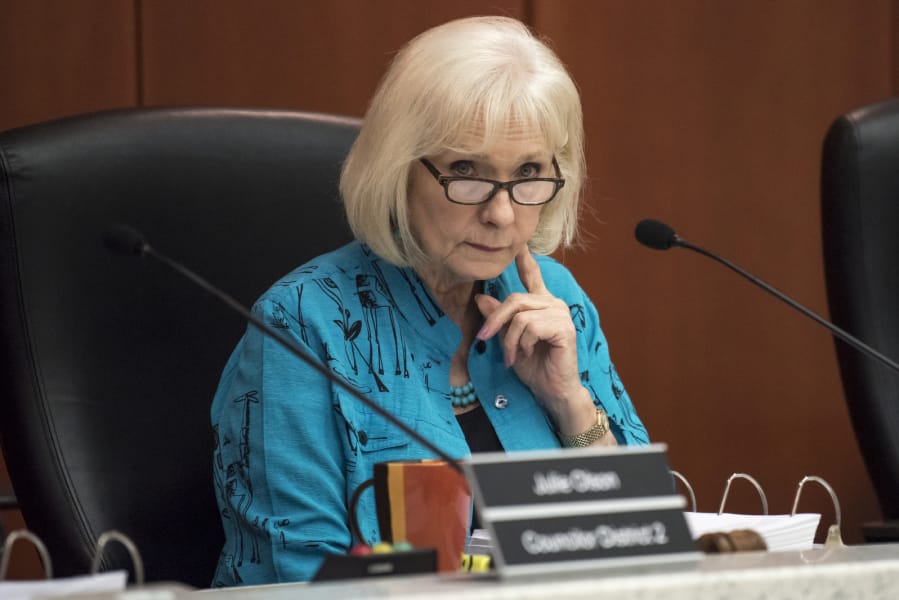County Councilor Gary Medvigy’s calls for better civility and collaboration among council members fell on deaf ears Wednesday as the Clark County Council met to discuss the ongoing pandemic, new voting district maps and when to resume in-person meetings. Discussions on all three subjects quickly became heated.
The Board of Health meeting began with Dr. Alan Melnick, Public Health director, updating the council on the latest case rates and hospitalizations for COVID-19 and the omicron variant.
Melnick said COVID-19 case rates rose from 903 cases per 100,000 people on Jan. 1 to 1,415 cases per 100,000 on Jan. 8. He said the county is consistently receiving reports of 600 to 700 or more new cases per day, with a high of 1,100 cases reported Friday.
“Given the resources, you can imagine how it becomes a lot more challenging, or whether it’s even effective, to be doing case investigation and contact tracing — especially when dealing with the omicron variant where … their close contacts become symptomatic in a little over two days,” he said.
Melnick said comparisons of hospitalizations of vaccinated versus unvaccinated patients he’s seen on social media are not calculated correctly. He said the most recent data shows the rate for hospitalizations due to COVID-19 is six times greater for those unvaccinated than for those fully vaccinated, and deaths related to COVID-19 are also greater for those who are unvaccinated.
With COVID-19 tests in short supply throughout the county, Melnick said, more kits should be available soon.
“The state will be setting up an online portal … where members of the public will be able to order at-home test kits and have them delivered directly to their homes,” he said.
Melnick also said the county has been working with health care and community partners to increase access to test kits, and monoclonal antibodies and antivirals for treatment.
“I’m glad to hear that hospitals are interested in therapeutics because I understand their protocol is, basically, to do nothing when you get to the hospital … except put you in a bed,” Council Chair Eileen Quiring O’Brien said.
“They’re not doing nothing. They’re caring for these patients, and there’s a lot they’re doing for them clinically,” Melnick said, adding that hospitals and doctors want access to treatments to reduce the strain on hospitals and health care workers.
Quiring O’Brien said she would like to hear from the hospitals directly if that is not their protocol.
Melnick said hospital administrators will be at the next Board of Health meeting on Jan. 26 to directly answer the board’s questions.
Quiring O’Brien also had changes she wants Public Health to make. She said the county should be promoting therapeutic treatments more than vaccines, noting that Melnick’s report was “pounding and pounding we need to have vaccines when in reality therapeutics work, too.”
Melnick previously said Public Health will only provide information on treatments proven to be effective, such as vaccines and monoclonal antibodies. Other treatments — like Ivermectin, chloroquine, hydroxychloroquine and bleach — have not been proven effective and would not be promoted, he said. Melnick also said Public Health is working with the state to increase access to proven treatments.
“One of the challenges with omicron is that the original monoclonal antibodies that were out are not very effective. There’s a new monoclonal antibody, but that’s in short supply. The state is working on getting that out,” he said.
For additional meeting information or an agenda, go to https://clark.wa.gov/calendar.
Redistricting maps
After the county redistricting committee failed to reach agreement on new voting district maps, the task fell to the county council. Wednesday’s preliminary discussion about the maps suggests the process won’t be any easier for councilors.
In November, voters approved a charter amendment changing the county from four voting districts to five districts. The five-member redistricting committee, made up of two members each from the county Republican and Democratic parties and Clark County Auditor Greg Kimsey, spent two months wrangling over the new boundaries but failed to reach a decision.
“What was known at the time when the charter review commission made this map was that they gerrymandered three sitting councilors into one district, thereby eliminating two of the majority of the council,” Quiring O’Brien claimed.
Charter Review Commission co-chair Chuck Green has disputed those claims.
“With our map, we made it clear we developed the five districts (boundaries) based on population estimates because the census data wasn’t available yet,” Green said previously.
Of the two maps proposed by the committee, map A2 was favored by the Republican members and map B2 was favored by the Democrats and Kimsey, who is a Republican. At that time, Kimsey said map B2 was the closest to what voters had approved in November.
Despite the endorsement from Kimsey, the Republican majority-led council favored map A2 and making any changes needed to accommodate new Census data. However, the members have not decided on or ruled out either map and will also consider a third map produced by the county’s Geographic Information Services department.
“It’s unfortunate the redistricting committee was unable to come to a consensus or a vote that would have moved a map forward,” Quiring O’Brien said. “Now it’s left to us, and I’m sure we’ll do our best.”
Quiring O’Brien, Medvigy and Councilor Karen Bowerman would be most affected by the district boundaries approved by voters and the boundary lines in map B2. Under these maps, all three council members would now reside in District 4. As Bowerman was elected as the District 3 representative, she could serve the remainder of her term but would have to run against Medvigy if he seeks re-election.
As all the council members could be affected by the district boundaries, and they are deciding those boundaries, Councilor Julie Olson said any map the council creates could be challenged in court.
“We’re way outside the charter,” she said.
Olson said she has asked the county’s legal counsel for guidance on the issue.
In an earlier interview, Kimsey said, “Legal counsel stated there’s nothing in the charter that deals with this so state law would govern. But state law doesn’t really reference county charter redistricting committees.”
The council tentatively agreed to again discuss redistricting at 10:30 a.m. Tuesday. It hopes to have a final map ready by Feb. 8.
In-person meetings
The county council’s meetings will continue to be held virtually rather than in person, at least for the next few weeks.
“Based on the reports we’ve had from Public Health and continuing cases and hospitalizations, it remains prudent to stay virtual,” Councilor Temple Lentz said.
Lentz suggested reviewing the decision on a month-by-month basis.
“What a difference a week makes,” Medvigy said, referring to the council’s last discussion on the subject on Jan. 5.
Medvigy said reports from other countries indicate that rates are starting to decline, and he was hopeful to see that in Clark County soon.
“As we see the numbers change, I think we should then reconsider,” Medvigy added. “We’re just not there yet.”
Olson suggested discussing the topic during the council’s first meeting in February. However, Quiring O’Brien said that with a public hearing on a proposed mini-initiative scheduled for Feb. 1, the council would need to make a decision sooner.
“I think the logistics of how we would handle an in-person meeting given the guidelines of the state still, masking requirements, Labor and Industries requirements, I think that would be a significant challenge for staff to try to manage,” Olson said.
County Manager Kathleen Otto noted that social distancing requirements would allow only 30 people to attend an in-person meeting.
With those limitations, the council agreed to continue holding its meetings remotely and also agreed to hold the public hearing on the mini-initiative remotely.
“Some of us want to get back to in-person meetings, but the time just isn’t working out right now,” Medvigy said.
The council will discuss holding in-person meetings again during council time on Feb. 1.




